Crusader Kings 3: Gold and buildings
On this page of the Crusader Kings 3 guide you will find tips and tricks on how to earn and spend gold (money), and how to build new buildings.
Last update:
On this page, we will discuss economic topics and focus on the resources and buildings available in the game. In the following paragraphs, you will learn what role gold has in the game and how to get rich. Then we will look at other types of resources and finally we mention buildings. Here, you will learn what types of buildings are available in the game and what are their restrictions and benefits.
Gold and taxes
Gold is the basic resource in the game. Unlike many other strategy games, in Crusader Kings 3, you do not gather wood, stone, or various metals. The basic resource you need to expand your kingdom is gold. This does not mean that there are no other resources in the game, but we'll cover these later on this page.
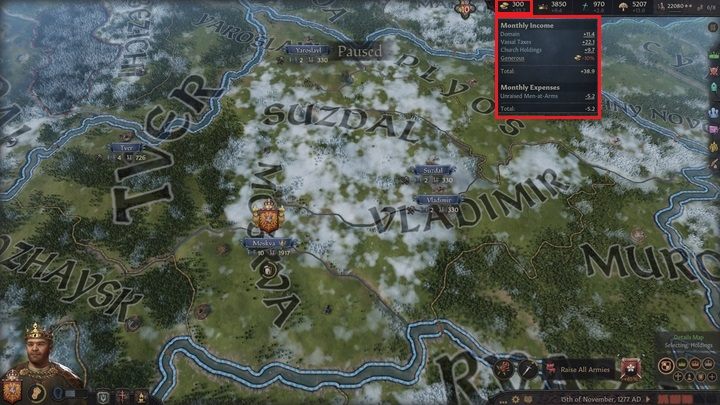
You can check the status of your resources at any time in the upper left corner of the screen. If you hover your cursor over the coins icon, you will see a detailed summary of your monthly income and expenses. The main source of your gains is taxes that you receive from your domain and vassals.
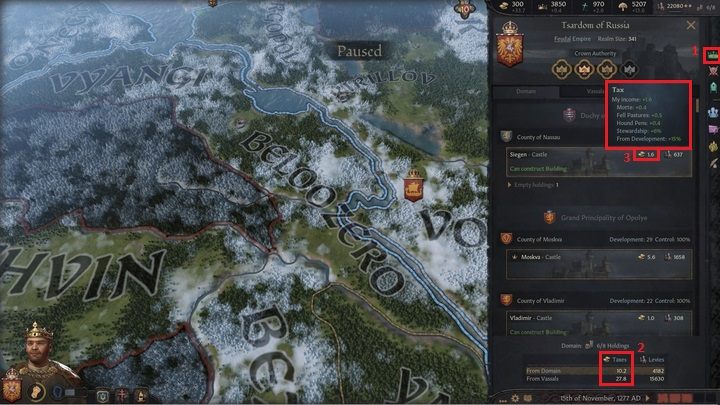
Detailed information on taxes can also be found in the Domain tab (1). At the bottom of the window, you will find a general overview of (2) income from the domain and vassals. In the case of domain income, you can also check what exactly affects the tax collection in specific counties. To do this, hover the cursor over the coin icon (3) in the section of the selected county. Here you can notice that buildings in counties provide a permanent bonus to tax revenues, while skills such as Stewardship or Development generate percentage multipliers. It also shows what opportunities you have to increase your earnings from the domain: you can expand counties by building new buildings or increasing their development level, or you can focus on your character's management skills.
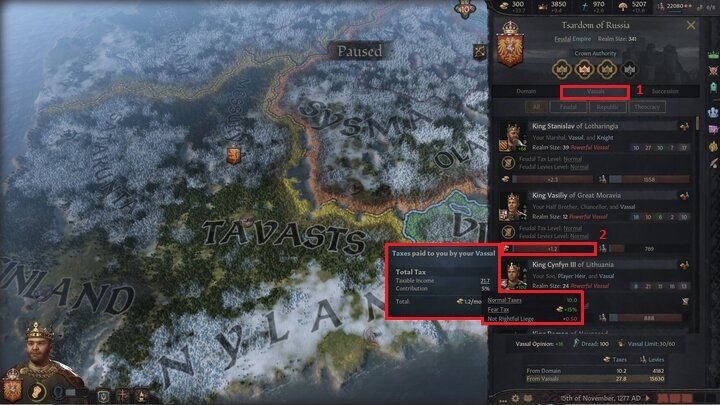
Using the Vassals tab (1), you can get equally detailed data on taxes imposed on your vassals. Under each their portraits, you will find an income rate and a coin icon (2). If you hover your cursor over it, you will see an additional window (3) with revenue details for this particular vassal. At this point, the most significant thing is the Contribution rate, which tells about what percentage of their income the vassal is giving you in the form of a tax. If you hover the cursor over the value of the contribution, you will see another window allowing you to examine what influences it exactly. As you can see in the example above, the lack of a De Jure title affects it greatly (you can learn more on the page about titles), which generates a severe negative modifier (-50%). At the same time, the value of the contribution can be increased, for example, with certain character skills (in this case, it is Fear Tax from the Torturer trait skill tree).
Income increasing skills:
Perk | Perk tree | Effect |
Tax Man | Architect | taxes collecting effectiveness increased by 25% |
Heregeld | Avaricious | vassal tax contribution increased by 10%; |
War Profiteer | Avaricious | monthly income at war increased by 20% |
Detailed Ledgers | Avaricious | the republican tax contribution increased by 15% |
Golden Aplomb | Avaricious | monthly income per stress level increased by 10% |
Avaricious | Avaricious | taxes from your domain (both counties and baronies) increased by 15% |
Honored to serve | Administrator | The contribution of Powerful Vassal Councillor (both for taxes and levy) increased by 20% |
Wealth Focus | For Stewardship lifestyle | increases monthly income by 10% |
Fear Tax | Torturer | Increases the contribution level of vassals with intimidated status by 10% and terrified by 20% |
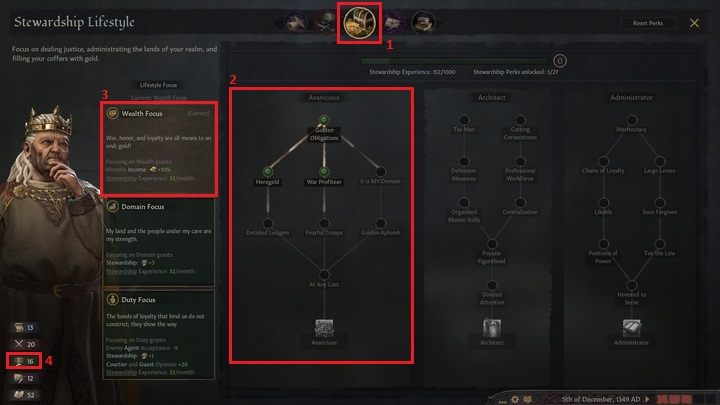
You will get the most income-increasing perks by developing your character in the Stewardship lifestyle (1). The Avaricious perk tree (1) is especially useful in this regard, as it focuses on multiplying your income, and you can gain additional effects by focusing on wealth (3). In addition, the Stewardship lifestyle level (4) of your character influences tax revenues from your domain. Each level above 8 will provide 2% of this type of tax, while each level below 8 will generate a -2% modifier. Thus, with Stewardship at level 10, you will receive 4% of taxes from your domain, but if you have this type of trait at level 6, you will receive a penalty of -4%.
Tax revenue at the county level, both in your and your vassal domain, also depends on the development level of each county. Each subsequent level of development guarantees a tax and levy bonus of 0.5%.
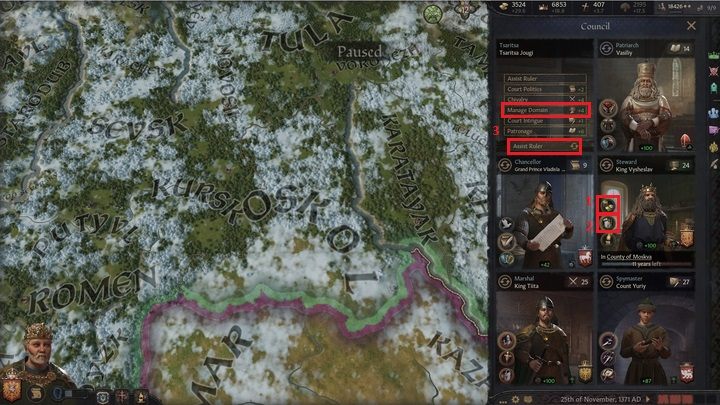
Of course, you can also increase tax income in other ways. One of them is assigning the task of collecting taxes (1) for your steward. This will give you a percentage bonus to taxes from your domain and a small chance your steward will gather an additional amount once a month. Of course, the effectiveness of the steward's actions depends on his management skills, so there also may be negative effects of them, for example, increased corruption in the county. You can also order the steward to increase the county's development level (2), which in the long run may turn out to be more profitable than increasing immediate tax income. If a character with a low management level gets the position of steward, you can always support him by assigning your partner patronage to help him (3).
You can also increase taxes from the domain by 5% using Windmills innovation (High Medieval Era).
Gold - other methods of getting rich
For most of the game, tax collection will be your main source of gold. Yet there are also less humane methods of making money, such as war, raids, kidnappings, and blackmail.
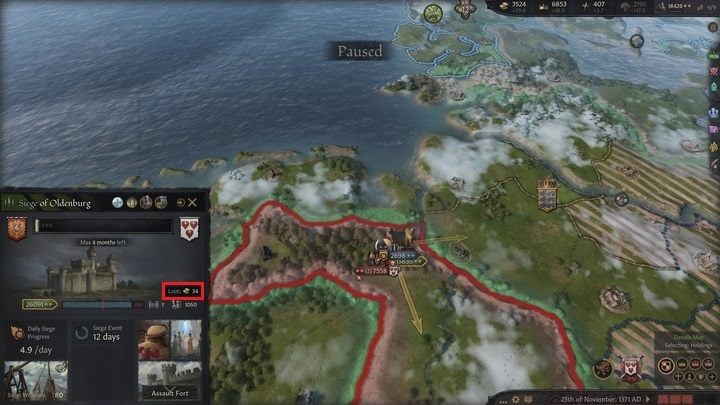
During the war, you can collect gold by taking over your opponent's buildings. During a siege, you always see what loot you will receive if you succeed in it. You can also find information on the potential loot in the regular barony window during a truce.
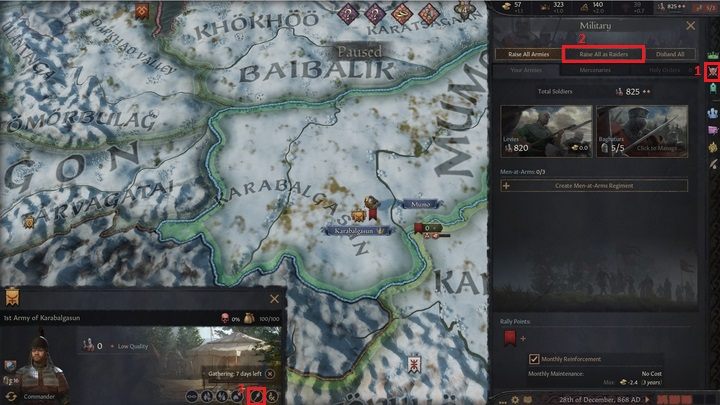
A specific type of military operation is Raid. It is a military operation run without declaring war to raise additional funds. Raids are available only if your character is a follower of an unreformed pagan faith, has a tribal type of rule, or the Legacy of Piracy dynasty modifier (granted by Elevate the Kingdom of Mann & the Isles decision). Your army have to be raiders to start a raid. Using the Military management window (1), you can immediately raise your troops to equip themself to become raiders (2), or you can do it in the army window already created (3). After that, it is enough to invade someone else's territory and successfully conduct a siege of a barony, city, or temple.
Although you do not officially declare war during the raid, you should usually expect a response from the attacked ruler. What's more, the loot you get during the raid will not be transferred to the treasury until your army returns to your territory. Of course, during the raid, you also have to pay your soldiers, but the army raised for this purpose has 50% lower maintenance costs. Nevertheless, raiding the other end of the map is usually unprofitable and risky (you should return with the loot in one piece). Good raid targets are your neighbors, not necessarily the weakest, who are currently at war on a different front.
Remember that you can also fall victim to the enemy raid. Each looted barony receives negative modifiers -50% taxes, 50% construction costs, and -10% to development for 5 years. For these reasons, it is not worth ignoring enemy raids, especially in the early stages of the game when your territory is small. Until negative modifiers end, the barony cannot be raided again.
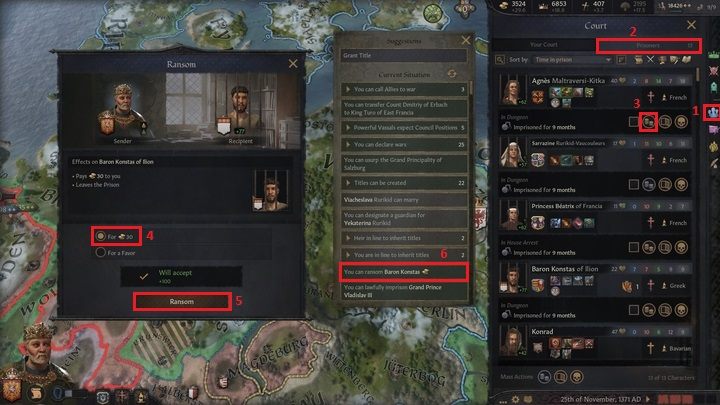
War and raids are generally quite expensive and precarious. This is mainly due to the army cost, the risk of failing the operation, and losing the loot (as a result of a raid). There is, however, another potential benefit associated with military operations, and that is prisoners of war. During a siege of the enemy's capital, you can capture your opponent's relatives and courtiers. This also applies to the possessions of his vassals. In general, if you are besieging a castle, there is a chance that you will capture the characters that were there at the moment. Aditionally, by winning a battle, you can capture enemy commanders. You can then free the prisoners in exchange for a ransom, which ranges from 10 to 500 gold. To do this, open the court management window and select the Prisoners tab (2). Below the portraits of individual prisoners, you will find coin icons (3) - if you can free the prisoner, this icon will be interactive. After clicking on it, you will see a window using which you can free the prisoner. If a ransom is available, you will find the appropriate option (4) with the information on how much gold you will get. Then all you have to do is click the Ransom button (5). Not every prisoner can be released for a ransom, but if there is potentially beneficial a guest in your prison, you will be informed about it by the current situation report (6).
Not every prisoner will be able to pay the full ransom right away. You can wait until they collect the full payment or free them for less gold. However, waiting for your prisoner to collect the full ransom creates a certain risk, as they may escape during this time. The greater the character's prowess stat, the greater the chance of escape is.

Releasing prisoners of war can be very profitable, but these are rather rare situations. To fill your prison, you can also try to imprison your own vassals. However, this is a very risky move as the vassal may disagree, which will lead to a civil war. Also, if you want to imprison a vassal legally, you need to have a hook on them. Otherwise, it will be considered an act of tyranny (-20 to the opinion of all vassals for each such act!). However, if you decide to develop an Intrigue Lifestyle for your character, invest in the Kidnapper perk in the Schemer perk tree. Thanks to it, you can plot an intrigue that will result in the imprisonment of the selected character.
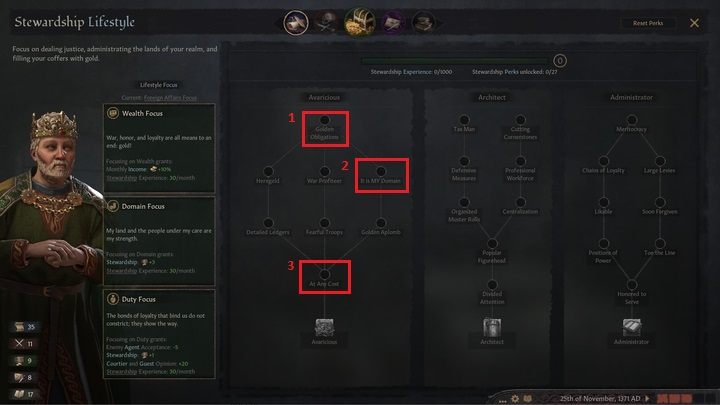
Another useful perk is Golden Obligations (1) from the Avaricious perk tree. It allows you to demand payment from another character in exchange for a hook you have on them. During the game, you will collect many hooks, and they will not always be useful, so it is worth selling some of them. Hooks can also be obtained by freeing the prisoners without collecting a ransom. So if you are concerned that your prisoner will escape, you can set them free and demand gold at a later time. In the Avaricious tree, you will also find the It is MY Domain (2) and At Any Cost (3) perks. The first allows you to make an Extort Subjects Decision, which will trigger two random events that allow you to get additional gold in exchange for some negative effect. The second one allows you to sell titles.
Buildings
Crusader Kings 3 is not a City Builder, but developing your domain with new buildings has a significant impact on the condition of your treasury and military strength.

Buildings are managed from the level of individual baronies. At the bottom of the barony window, you will find slots for buildings. Basically, each barony has 3 building slots. If the barony is the capital of a County or Duchy, the slot number is increased to 4 and 5, respectively. Additionally, there are special buildings in the game with separate dedicated slots.
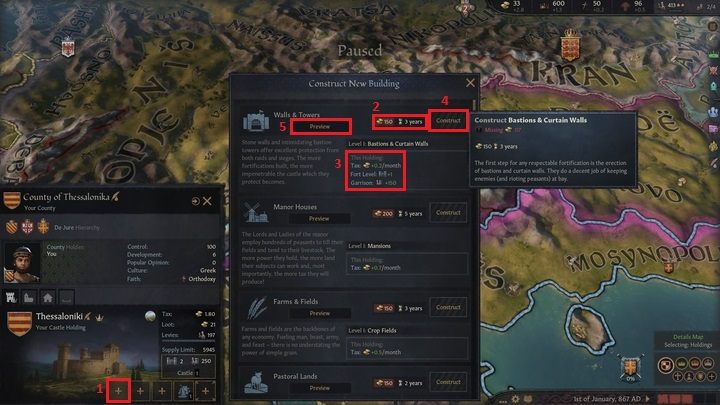
You can only place new buildings on free slots, meaning those marked with a plus icon (1). If you click on such a slot, you will see a window with a list of possible buildings on the right side. Next to each object, you will find information about the cost, construction time (2), and the benefits of the facility (3). To start the construction, click on the Construct button (4). Hovering the cursor over this button also allows you to check the requirements to build it. One important element of this window is the Preview button (5). Thanks to this option, you can check the next development levels of a given building.
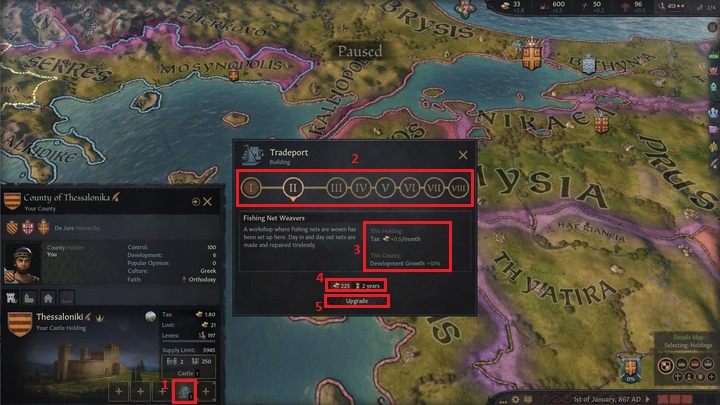
Most of the buildings in the game can be upgraded. If you click on a slot that is already occupied by a building (1), the upgrade window will be displayed. At the top of the window (2), you will find information about the upgrade levels of the selected building. Possessed upgrades are marked with filling, while selected ones are highlighted. Below, you can check what benefits (3) are offered by the selected upgrade, its cost, and construction time (4). Upgrades can only be made in a specific order and often require knowing specific innovations within your culture. You confirm the decision to develop a building with the Upgrade button (5). If you do not meet the requirements, you can check them by hovering over this button.
Innovations needed to improve buildings:
Era | Type of building | Innovation |
Tribal | Fortifications | Mottes |
Tribal | Military buildings | Barracks |
Tribal | Economic buildings | Crop Rotation |
Early Medival | Fortifications | Battlements |
Early Medival | Military buildings | Burhs |
Early Medival | Economic buildings | Manorialism |
High Medival | Fortifications | Hoardings |
High Medival | Military buildings | Castel Baileys |
High Medival | Economic buildings | Windmills |
Late Medival | Fortifications | Machicolations |
Late Medival | Military buildings | Royal Armory |
Late Medival | Economic buildings | Cranes |
By the needed innovations, buildings can be divided into three types: economic buildings, military buildings, and fortifications. By the needed innovations, buildings can be divided into three categories: economic buildings, military buildings, and fortifications. Fortifications are castles and all their upgrades. They are primarily of military importance.
If you have a tribal government, your options will be limited to only four types of buildings: Gathering Halls, Markets, Palisades, and War Camps. Each type offers two building variants, and most of them guarantee positive effects for your entire kingdom.
A much larger range of buildings is available for feudal or clan government forms. In these governments, most buildings have county-level effects. What buildings you can build will also depend on the type of barony, its status, and terrain. Therefore, some buildings can only be built in cities or temples (e.g. guilds), while others only in the capital of the duchy (e.g. blacksmiths).
You are not permitted to copy any image, text or info from this page. This site is not associated with and/or endorsed by the developers and the publishers. All logos and images are copyrighted by their respective owners.
Copyright © 2000 - 2025 Webedia Polska SA for gamepressure.com, unofficial game guides, walkthroughs, secrets, game tips, maps & strategies for top games.
